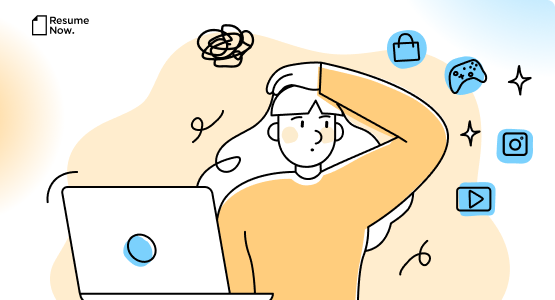Table of contents
Writing a cover letter is an essential step toward landing a job that excites you. But with so much information to communicate and so little time to grab the employer's attention, it can be hard to know if you're making the right decisions. How long should a cover letter be for a job? This might seem like a simple question, but the answer can make a big difference in your career's future. Our guide has the answer.
Our guide covers:
- How long a cover letter should be.
- What sections to include in a cover letter.
- What to do if your cover letter is too long.
- What to do if your cover letter is too short.
- An example cover letter to help you get started.
- Key takeaways.
Ready to get started on your cover letter? Our Cover Letter Generator takes the guesswork out of writing a cover letter with ready-to-use templates and AI content assistance to help you write a cover letter in just minutes.
How Long Should a Cover Letter Be?
There is no exact word count that a cover letter has to aim for, but that doesn't mean that you shouldn't keep length in mind as you write your cover letter. The exact length of your letter should depend on what you have to say, but a general rule of thumb is that cover letters should be between half a page and a full page. This typically means that your word count should be between 250 and 500 words, but focusing on a specific number is not ideal. Instead, break your cover letter down into sections and make sure each section communicates efficiently.
A typical cover letter runs between three and six paragraphs, but the important thing is that your cover letter is the correct length to communicate your career details. You should never pad your letter for length by adding unnecessary "fluff" or replacing concise sentences with long and wordy ones.
On the other hand, if you have a lot to say, try not to pack your cover letter too densely. A cover letter should be easy to read and understand what the candidate brings to the table. Overstuffing your letter can have the opposite effect.
What Should You Include in a Cover Letter
Cover letters are made up of several basic sections that you should keep in mind as you plan out the length of your letter. Each section needs its own space to accomplish its purpose. Here are the basic cover letter sections:
- A cover letter header: Your cover letter header should only take up one or two lines. In this section, you'll provide your name, up-to-date contact details such as your email address and phone number, your location, and any relevant professional links you wish to include, such as a LinkedIn profile or digital portfolio.
- A polite address: Depending on whether your letter is being emailed or submitted digitally (snail mail is very uncommon for cover letters nowadays), you may include a section with the hiring manager's name, title, and location. This isn't always necessary, but whether or not you include it, you must address your letter to someone. Addressing it to a hiring manager or recruiter by name is ideal, but "Dear Hiring Manager" works as an alternative.
- An introductory paragraph: Next, your cover letter needs to introduce who you are and what you do for the employer. This section should be brief and should take no more than three sentences. Introduce yourself and describe your career, but save the in-depth details for your body paragraphs.
- Several body paragraphs: Most of the word count of your cover letter is going to come from your body paragraphs. In your body paragraphs, describe your relevant skills and experience, focusing on measurable outcomes and specific skills that align with the job description. This is also your place to discuss any unique details from your career that you would like to add context to. If you have gaps in your employment or a career change, your body paragraphs are your chance to discuss how those things ultimately contributed to where you are today career-wise.
- A conclusion: Your cover letter's conclusion should be one paragraph in length. It should briefly reiterate why you're the right fit for the role, remind the employer of your interest in an interview, and thank them for their consideration. Three sentences should be more than enough for your concluding paragraph.
- A signature: Make sure to leave room for a signature at the bottom of your cover letter. Typical sign-offs are "Sincerely" and "Warm Regards." Avoid excessively stiff signatures, and do not use casual or familiar language in your sign-off.
What Should You Do If Your Cover Letter Is Too Long?
I didn't have time to write a short letter, so I wrote a long one instead.
– Mark Twain
Having too much to say on your cover letter is not a bad problem to have, but how can you trim your content down when every sentence feels important? Here are some tips!
Tip #1
Look for repetition.
When space is limited, repeating information becomes a significant burden on your cover letter's length. Make sure that each detail you touch on is unique and adds a new dimension to the skills and achievements that you bring to the table.
Tip #2
Let your resume do the talking.
A cover letter and a resume should work together to give employers confidence in your abilities. What's the point of writing a strong resume if you're just going to repeat it all in your cover letter anyway? Let both documents feel unique by avoiding repeating your resume's content. Instead of summarizing your entire career history, focus on drawing attention to a few key points that fit the role you're applying to and use your letter as your opportunity to give those points more detail than your resume allows.
Tip #3
Get comfortable with white space
Less is more is a hard lesson to internalize. But it's essential for writing a strong cover letter. Learn to love the white spaces on your letter and embrace the balance between the empty and full spaces on the page. This will help you eliminate filler.
Tip #4
Show, don't tell
When it feels like it takes a whole paragraph to explain a simple achievement, odds are that you're "telling" a lot more than you're "showing." Stay focused on outcomes instead of trying to sell your contributions. Use numbers and specific results to demonstrate your achievements in fewer words.
Tip #5
Phone a friend
If you're having trouble trimming down your cover letter, why not seek a second opinion? Ask a friend, colleague, or even an AI assistant to look at your cover letter and point out repetitive or unnecessary areas. This is one of many ways that you can use ChatGPT for a cover letter without compromising the integrity of your voice.
What Should You Do If Your Cover Letter Is Too Short?
Trimming down a long cover letter is challenging, but what about filling out a short one? How can you make your brief cover letter long enough without adding filler or fluff?
Tip #1
Discuss extracurricular activities
If you're having a hard time meeting the expected length for your cover letter, odds are that you don't have a lot of experience to discuss. Even if you're writing a cover letter for your first job, you probably have more to talk about than you think. Discuss the transferable skills that you've earned through hobbies and extracurricular activities.
Tip #2
Emphasize academic achievements
If your cover letter doesn't have enough on-the-job accomplishments to carry its length, go back in time a bit. You can always discuss academic achievements or relevant coursework that have contributed to your professional skills.
Tip #3
Discuss the role
Your cover letter is a great opportunity to discuss why you're interested in the role. Highlight specific keywords and skills from the job description or focus on the organization's values and how they align with your own career values. Employers cherish employees who are eager to contribute to their company culture.
Tip #4
Highlight personal projects
Just like with academics or extracurricular activities, your personal projects can contribute a lot to your resume. Working on relevant projects in your free time shows dedication and enthusiasm.
Cover Letter Example
Having a hard time visualizing how a successful cover letter makes use of limited space? Check out this cover letter example for a visual reference of how white space and balance contribute to a persuasive letter.
Key Takeaways
-
Cover letters should be between a page and half a page long.
As a rule of thumb, half a page to a full page is the ideal length for a cover letter. Don't target a specific word count; instead, focus on creating a cover letter that communicates effectively within these parameters.
-
Plan the length of your cover letter with the typical sections in mind.
A cover letter is made up of sections that each require their own space. Plan each section before you start writing to have a basic outline for how much space each section will take.
-
Trim down wordy cover letters.
If your cover letter is too long, trim it down by avoiding repetition, making sure your content is unique and different from your resume, and focusing on outcomes that you can show without having to explain.
-
Use extracurriculars and values to make your cover letter longer.
A cover letter's length should never be padded with fluff. Instead, if your letter is too short, focus on meaningful details that you can add that will contribute to your letter. Include relevant hobbies, extracurricular activities, academic achievements, personal values, or projects as needed.
Resources to Help With Your Job Search
- 21st-Century Skills for Your Resume
- Networking Skills for Your Resume
- The Perfect Resume: A Detailed Guide (+ Examples)
- How to Write a CV: The Complete Guide
- How to List References for a Resume With No Experience
- How to Update Your Resume (Guide + Expert Tips)
- How to Prepare for a Job Interview
Was this information helpful? Let us know!
Hailey Brophy is an experienced writer with a diverse career in digital publication. She is passionate about using her unique skills and experiences to help job seekers find the information that they need to succeed.
More resources

Hobbies and Interests to Put on Your Resume: Examples & Guide
Showcase individuality and drive by putting hobbies and intere...

How to List Relevant Coursework on a Resume (With Examples)
Wondering how to list relevant coursework on a resume to show ...

Graphic Designer Resume: Examples & Templates for 2025
Was this information helpful? Let us know &star &star &star &s...

Engineering Manager Resume: Examples, Templates & Tips for 2025
Was this information helpful? Let us know &star &star &star &s...

Hotel Manager Resume: Examples, Templates and Tips for 2025
Need a hotel manager resume that lands you an interview in 202...

